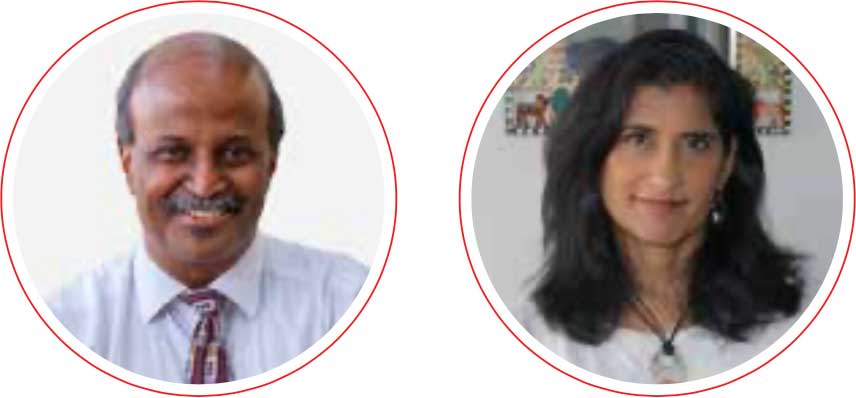Ways In Which COVID-19 Pandemic Could Unfold

As the COVID-19 rages on globally, Asst Prof Jyoti Somani and Professor Paul Ananth Tambyah look at how the pandemic could play out.
With over 2 million people infected, the COVID-19 pandemic has affected all countries as well as many of the territories of the world, with the majority of infections in the United States and Europe.
The World Health Organisation has stated that this is the first pandemic to be caused by a coronavirus and originally postulated that this could be the first pandemic to be controlled. The current hotspots of COVID-19, the US and some of the European countries, seem to have reached a turning point, for a combination of reasons including severe movement restrictions or “lockdowns”.
There are now over 500 clinical trials registered for the treatment and prevention of coronavirus, and a phase 1 vaccine trial already underway, though no drugs or vaccines are currently licensed for this infection. With the high caseloads in recent weeks, there have been concerns about intensive care resources as well as personal protective equipment for healthcare workers and other first responders, particularly in Italy and the US. Innovative approaches to production and manufacturing, reduced demand from China as well as a “flattening of the curve” in various countries, have alleviated these concerns somewhat.
If the disease does indeed plateau in Europe and North America, it would be important at this point to look at India, Bangladesh and the countries of Africa. The extent of COVID-19 disease in these densely populated countries can be determined through large sentinel surveys using existing systems such as influenza-like illness surveillance or even better, through large scale serological studies. This will answer the question whether the tropics will sustain transmission through the northern summer or if the warmer weather will limit the spread to pockets where people are living in close quarters, such as in slums and refugee camps.
Two Trajectories The Global Spread Could Take

Like SARS, the vast majority of patients with COVID-19 will experience a mild illness. A small proportion, about one in 10, will require intensive care, and some may not survive.
Like SARS, the vast majority of patients with COVID-19 will experience a mild illness. A small proportion, about one in 10, will require intensive care, and some may not survive. While China and the US Centers for Disease Control and Prevention have reported that nearly half do not survive being critically ill and on a respirator, this may be more reflective of an older, sicker population or later access to healthcare. Other countries, including Korea, Germany and Singapore have so far, had a higher percentage of patients who survive critical care mainly due to younger populations being infected.
Scientists are speculating what proportion of the population will get infected with SARS-COV-2. For influenza A H1N1 in 2009, we know that figure was around a quarter of the population after the first wave of infection. We also know that COVID-19 is more severe than influenza so the impact on healthcare systems, especially in low and middle-income countries can be significant if such large proportions of the population are infected. Unfortunately these middle and low income countries do not have widespread infrastructure for ICU beds and ventilators, but they do tend to have generally younger populations which are known to be less susceptible to more serious illness.
With SARS, testing only became available weeks after the outbreak began, meaning that many mild cases early on were missed, inflating the fatality rate.
We are only just seeing the rollout of rapid PCR-based diagnostic tests worldwide and even the introduction of serological based tests. After a slow start, the United States has now tested more than 1% of its population, a higher proportion than Singapore or Korea, which previously led the way in testing. Once the rest of the world catches up, and once there is widespread serological testing, the overall case fatality rate will likely be around 1-2%.
The other big difference between SARS and COVID-19, especially in countries previously affected by SARS, is the high degree of healthcare worker protection, which may mean lower rates of infections in medical professionals working on the frontlines.
As this virus is most infectious at the onset of symptoms, it is possible that many healthcare workers are actually infected outside of work. There has been a report from Changi General Hospital in Singapore showing that even during an intubation procedure on a critically ill patient, healthcare workers were not infected despite many wearing only surgical masks. Without detailed molecular epidemiologic analysis (i.e. RNA fingerprinting), it is not certain where the infected healthcare workers are getting exposed. Tragically, many older healthcare workers and a few younger ones have died from COVID-19.
 It is important to keep in mind that the extent of the global outbreak in the following months will depend on many key factors that can be shaped.
It is important to keep in mind that the extent of the global outbreak in the following months will depend on many key factors that can be shaped.
There are two possible scenarios we foresee going forward, but it is important to keep in mind that the extent of the global outbreak in the following months will depend on many key factors that can be shaped: these include public health responses, developments in rapid testing, effectiveness of widely adopted lockdowns and physical distancing measures, demonstration of effective treatments and potentially the roll-out of a vaccine.
In the first scenario, the epidemic slows down in the northern hemisphere as it starts to warm up. Even now, the countries with high chains of transmission are those where the temperature remains in the 10 to 20 degrees Celsius range and below—the United States, Europe (Italy, France, Spain, UK), Iran and Turkey.
While many tropical countries have had some cases, there has not been widespread community transmission so far in most, perhaps because the higher humidity and warmer weather may be preventing rampant spread, as the virus cannot survive so long in the environment and on inanimate objects in warmer temperatures. There will still be clusters of spread within close contacts and super spreading events which have not been fully explained thus far.
While the virus might disappear altogether in the northern summer like SARS, there is also the risk that, similar to the influenza pandemics of 1918, 1957 and 1968, the COVID-19 outbreak may slow down during the northern hemisphere summer season, but return in a second wave in October or November when it gets cold again.
The second possible scenario is that the COVID-19 disease may turn out not to be sensitive to temperatures, in which case, the spread of infection will continue worldwide for months, at least until herd immunity develops in communities. The strategy of “flattening the curve” is aimed at preventing healthcare systems from being overwhelmed and has underpinned many severe lockdowns and implementation of social distancing in most countries. While this may indeed achieve the desired outcome, importantly, the overall number of COVID cases will likely not decrease. Rather, it is just that they are spread out over time. The ideal is that a vaccine is developed sooner rather than later, so that the overall number can really drop, or that effective treatments are identified so the community cases can drop below a level needed to sustain transmission.
These lockdowns are hard to sustain and there is always the fear that there will be a resurgence of infections if they are terminated prematurely. A concern about full shutdowns has been that herd immunity does not easily develop. One epidemiologist has suggested a strategy of serial lockdowns to allow for the development of herd immunity. Thus, even after the lock down lifts, the contract tracing, isolation of cases and close contacts, and aggressive testing must continue. Regardless, the “exit strategy” has to be based on solid scientific understanding of the extent of the disease in the population as well as the potential sites for super spreading events which can be targeted for enhanced surveillance.
Three Scenarios for Large Outbreaks
The spread of SARS-COV-2 virus remains foremost droplet and contact (direct or through objects). Singing has been speculated to disseminate droplets, which carry the infection. With careful contact tracing and quarantining, along with close surveillance and testing, Singapore has been able to clearly show the typical pattern of spread. There is pre-symptomatic and symptomatic transmission, including some unusual situations where the contact was only through the same seat in a church, which highlights the gaps in our understanding of the transmission of this virus.
While the vast majority of patients with COVID-19 do not spread the infection at all and some spread the infection to only a couple of family members, there are some unique situations that have resulted in much more extensive spread – these have been dubbed “super spreading events”.
One of the first super-spreading events was the Diamond Princess cruise ship that remained off the coast of Japan for 14 days. Eventually, a total of 712 persons were infected out of 3,711 persons on board, as well as some public health officers.
Cruise ships are already well known for outbreaks of other highly infectious pathogens including the norovirus (known locally as “stomach flu”) and influenza for a variety of reasons. These include the close quarters in which passengers and crews find themselves, the risk of environmental contamination and generally older populations. Since the Diamond Princess cruise ship event in Japan, there have been a number of other instances, including the Grand Princess in California, the Ruby Princess in Australia and most recently the Grand Mortimer, a cruise ship that was headed to Antarctica. The latter had a 60 per cent rate of secondary infections. On this last cruise, the virus was likely brought on by passengers. Thus far, Antarctica remains free of SARS-COV-2!
In Singapore, Saudi Arabia, Bahrain, and the UAE, among other places, there are clusters of infection that are occurring in dormitories of foreign workers. This is not unexpected, as these are settings where 8 to 20 workers are housed in close contact. Unfortunately, once these dormitories are quarantined, the virus is likely to spread rapidly within the confined space similar to what happened on cruise ships. Widespread testing of all workers, and separating all workers while treating those who are positive may help to diminish ongoing transmission.
Prisons and detention centres are another area where there has been unintended and rapid spread of COVID-19 abroad, and it would be prudent to be monitoring these sites closely here in Singapore and elsewhere.
![]() Second, large gatherings where people gather, sing or share food, can potentially lend themselves to huge outbreaks should there be someone shedding large quantities of virus.
Second, large gatherings where people gather, sing or share food, can potentially lend themselves to huge outbreaks should there be someone shedding large quantities of virus.
The huge and rapid outbreak in South Korea among members of a religious group, which had more than 200,000 members, accounted for more than half of the over 7,000 cases of COVID-19 infections in the country.
![]() Third, a large outbreak could happen in communities where there are big numbers of people susceptible to the virus. The nightmare scenario for public health is the COVID-19 outbreak at nursing homes, such as the one in Seattle, Washington. The home became the early epicentre of the outbreak in the US with high rates of COVID-19 related deaths. Nursing homes have elderly patients with many comorbid conditions. Many live in close quarters with common staff and caretakers, who can bring the virus with them to work.
Third, a large outbreak could happen in communities where there are big numbers of people susceptible to the virus. The nightmare scenario for public health is the COVID-19 outbreak at nursing homes, such as the one in Seattle, Washington. The home became the early epicentre of the outbreak in the US with high rates of COVID-19 related deaths. Nursing homes have elderly patients with many comorbid conditions. Many live in close quarters with common staff and caretakers, who can bring the virus with them to work.
Thus, there is always a risk of healthcare-acquired infections which can spread rapidly, including influenza and other respiratory viruses, norovirus and other gastrointestinal illnesses. The COVID-19 outbreak has led to new screening, visiting and other precautionary measures in many nursing homes and assisted-living facilities world-wide. The fear remains that if such incidents occur in other long-term care facilities across the world, the toll on elderly or disabled people from COVID-19 will be significant.
Focus On Medical Developments, Relooking Large Gatherings And Encouraging Testing
Three areas of focus lie ahead in the fight against COVID-19.
![]() First, scientists are already working on treatments. There are studies now enrolling patients (with some well underway in Singapore) to see if any of the known and newer anti-viral drugs will be effective. There are also plans to conduct trials of preventive drugs among at-risk populations in Singapore too.
First, scientists are already working on treatments. There are studies now enrolling patients (with some well underway in Singapore) to see if any of the known and newer anti-viral drugs will be effective. There are also plans to conduct trials of preventive drugs among at-risk populations in Singapore too.
![]() In addition, newer and more effective tests are being developed, including blood tests that can tell whether a person has already been infected, such as the one used by Duke-NUS to establish the link between the two church clusters in Singapore. Studies conducted at the National Centre for Infectious Diseases (NCID) and also in China show that serology does not usually become positive until at least two weeks after the onset of illness, so these tests cannot be used for the acute diagnosis of illness. However, they will be able to be used to identify an immune population who could be approached for obtaining plasma that may contain protective antibodies. Giving convalescent plasma with high levels of antibodies from recovered patients to sick patients with COVID-19 is currently one of the treatment approaches being planned by the NCID here in Singapore.
In addition, newer and more effective tests are being developed, including blood tests that can tell whether a person has already been infected, such as the one used by Duke-NUS to establish the link between the two church clusters in Singapore. Studies conducted at the National Centre for Infectious Diseases (NCID) and also in China show that serology does not usually become positive until at least two weeks after the onset of illness, so these tests cannot be used for the acute diagnosis of illness. However, they will be able to be used to identify an immune population who could be approached for obtaining plasma that may contain protective antibodies. Giving convalescent plasma with high levels of antibodies from recovered patients to sick patients with COVID-19 is currently one of the treatment approaches being planned by the NCID here in Singapore.
![]() Second, the need to cancel large gatherings and the impact of social distancing can be better examined once more reliable testing on a population basis can be done.
Second, the need to cancel large gatherings and the impact of social distancing can be better examined once more reliable testing on a population basis can be done.
Third, while countries focus on containing the virus, the key is still in identifying every case. In addition to broadening testing, providing free treatment or compensation for those on medical leave is critical to encourage people to get tested and treated, to ensure that they will not be penalised by their employers, or be deterred by the thought of potential financial difficulties.
This is especially challenging in low-income countries and low-income households with sole bread-winners.
![]() Difficult decisions will have to be made while we wait for the scientific consensus as well as the development of new treatments and vaccines.
Difficult decisions will have to be made while we wait for the scientific consensus as well as the development of new treatments and vaccines.
Public health authorities must decide when to move from containment, which requires doing costly and labour-intensive contact tracing for every case, to mitigation, where we focus on those who are most vulnerable to prevent complications while keeping track of the situation in the broader community.
With the concerted global effort of clinicians, scientists, public health professionals and the public, there is a good chance we will succeed in limiting the suffering and deaths from COVID-19.

Assistant Professor Jyoti Somani (right) and Professor Paul Ananth Tambyah (left) are from the Department of Medicine. Prof Tambyah is also President of the Asia Pacific Society of Clinical Microbiology and Infection.
All information stated in the article is correct at time of printing. The information contained herein may change subject to changes in prevailing medical guidelines.
